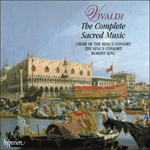
Welcome to Hyperion Records, a British classical label devoted to presenting high-quality recordings of music of all styles and from all periods from the twelfth century to the twenty-first.
Hyperion offers both CDs, and downloads in a number of formats. The site is also available in several languages.
Please use the dropdown buttons to set your preferred options, or use the checkbox to accept the defaults.

The emotional core of RV641 is its solitary central aria, which successfully conveys a mood of dignified lamentation appropriate to Passiontide. This movement epitomizes Vivaldi’s ability to achieve overpowering expression by the very simplest means. Geltruda reportedly had a soft voice, and one notes Vivaldi’s constant efforts (by muting, or temporarily omitting, the strings) to ensure that the singer is never drowned.
It is impossible to carry out Vivaldi’s original intention by appending the Miserere, but to allow RV641 to have no sequel at all is equally impossible. This recording resolves the problem pragmatically by following this introduzione with the Stabat mater, which is at least related by key, mood, subject, season and period of composition, even if it belongs to a different liturgy.
from notes by Michael Talbot © 1999
Cœur émotionnel de RV641, l’aria centrale, solitaire, parvient à véhiculer une atmosphère de lamentation digne, appropriée aux deux dernières semaines quadragésimales. Ce mouvement incarne la capacité de Vivaldi à obtenir une expression irrépressible avec les moyens les plus simples. Geltruda passait pour posséder une voix douce, et Vivaldi fit de constants efforts (en étouffant les cordes, ou en les omettant temporairement) pour s’assurer qu’elle ne fût jamais noyée.
S’il est impossible de respecter l’intention originelle de Vivaldi en enchaînant avec le Miserere, il est tout aussi impossible de laisser RV641 sans suite. Le présent enregistrement résout le problème de manière pragmatique, en programmant le Stabat mater qui, bien qu’issu d’une toute autre liturgie, n’est pas sans un lien de tonalité, d’atmosphère, de sujet, de saison et de période de composition.
extrait des notes rédigées par Michael Talbot © 1999
Français: Hyperion Records Ltd
Emotionaler Kern von RV641 ist seine einzige, zentral angesiedelte Arie, die mit Erfolg eine der Passionszeit angemessene Atmosphäre würdevollen Klagens vermittelt. Der Satz spiegelt Vivaldis Fähigkeit wider, mit einfachsten Mitteln überwältigende Ausdruckstiefe zu erzeugen. Geltruda soll eine zarte Stimme gehabt haben, und man vermerkt Vivaldis ständiges Bemühen (indem er die Streicher dämpft oder gelegentlich ganz wegläßt), dafür zu sorgen, daß die Sängerin nicht übertönt wird.
Es ist nicht möglich, Vivaldis ursprünglicher Intention zu entsprechen und das Miserere anzuhängen, aber ebenso unmöglich wäre es, überhaupt nichts dahinter zu setzen. Die vorliegende Aufnahme löst das Problem pragmatisch, indem sie dieser introduzione das Stabat mater folgen läßt, das ihr wenigstens durch seine Tonart, seine Stimmung, sein Thema, seine Aufführungs- und Entstehungszeit verwandt ist, auch wenn es einer anderen Liturgie angehört.
aus dem Begleittext von Michael Talbot © 1999
Deutsch: Anne Steeb/Bernd Müller
 Vivaldi: The Complete Sacred Music Vivaldi: The Complete Sacred Music‘For King's sterling service to the Vivaldian cause, one of his most important recording and satisfying projects to date, I am thankful’ (Gramophone) ‘If you're waiting for the perfect collection of Vivaldi's sacred music, this is it. It was a happy day when this beautiful boxed set arrived in my m ...» More |

